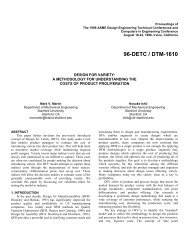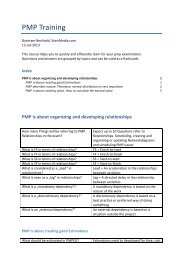Social Marketing
You also want an ePaper? Increase the reach of your titles
YUMPU automatically turns print PDFs into web optimized ePapers that Google loves.
10<br />
The Basics<br />
Thinking Like a Marketer<br />
One way to get a handle on understanding an audience is to break it down into groups. This is<br />
called “segmentation.” The idea of segmentation is to break up the entire audience into smaller<br />
groups with whom you can use the same strategies to reach and persuade them. It also requires<br />
being as specific as possible in describing exactly who you’re reaching, because for each<br />
segment, you might reach members of the audience in a different place, and when you reach<br />
them use a different pitch.<br />
The best way to implement this<br />
principle is to define and promote<br />
a specific, simple action for the<br />
target audience to perform.<br />
If you are having difficulty grasping segmentation,<br />
consider different ads on TV or in magazines.<br />
Commercial ads simply do not attempt<br />
to reach the entire U.S. population. In fact, it is<br />
usually pretty easy to determine who the audience<br />
segment is for a specific ad. Some ads<br />
are directed to men who watch football; others<br />
are directed to women who are at home during the day. They are not only selling different products,<br />
but also using different strategies that match the characteristics of the target audience.<br />
2. Your bottom line: When all is said and done, the audience’s action is what counts.<br />
Unlike classroom teaching or entertainment, all marketers really care about is action. You want<br />
people to perform a behavior – in the CFL case, to buy, install, or recommend efficient lighting.<br />
Although you might want to educate people about the benefits of CFLs, the attributes of your<br />
brand or the dangers of wasting energy, if you do not get them to take action, your program has<br />
failed. It has failed regardless of how much people learned about how great CFLs are, or how<br />
readily they can identify your brand.<br />
The best way to implement this principle is to define and promote a specific, simple action for<br />
the target audience to perform.<br />
And remember: What looks like a simple, straightforward action to us is sometimes more<br />
complex to your audience. The clearer you are about the action or behavior, the more successful<br />
your programs will be. Behavioral scientists can help you to analyze a behavior. While you<br />
may not have those credentials, you can break larger actions into steps in order to understand<br />
where problems may lie in getting people to perform complex behaviors.<br />
3. Make it easy-to-irresistible for your audience to act.<br />
As noted earlier, social marketing includes the concept of exchange - the assumption that<br />
people behave in certain ways in exchange for benefits they hope to receive. People weigh<br />
options and make these behavioral choices within complex environments.<br />
Basically, if people believe that something benefits them, they will take action. If they believe<br />
there are more costs than benefits to taking action, they typically will not do so. What marketers<br />
are looking for is the tipping point – the point where people believe that there are enough<br />
benefits to outweigh the barriers, or that the benefits matter more than the barriers.

















